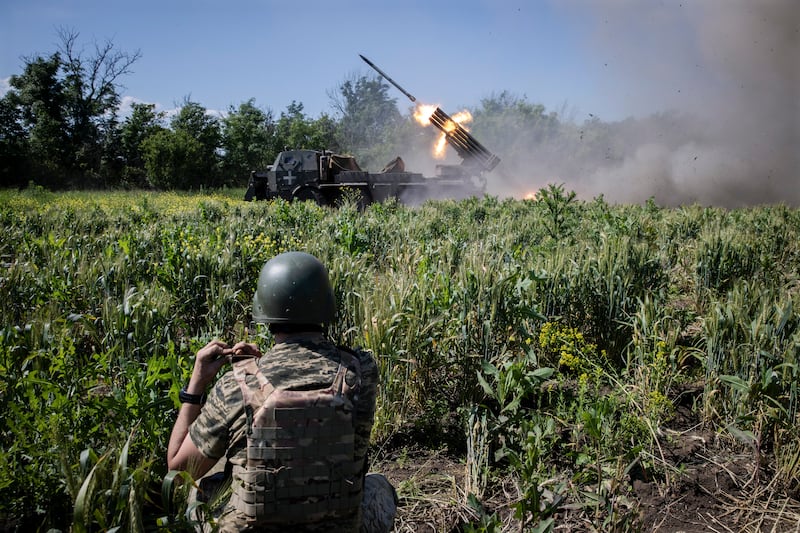At Nato’s summit this week, allies were careful to stress their staunch support for Ukraine in the face of Russia’s invasion, and for its leader Volodymyr Zelenskiy.
But after Zelenskiy blasted Nato for its “absurd” lack of a clear timeline for Ukraine’s entry, tensions began spilling into the open. Referring to Kyiv’s long military wish list, British defence secretary Ben Wallace said on Wednesday: “You know, we’re not Amazon.”
“Whether we like it or not, people want to see gratitude,” Wallace told reporters, echoing a common sentiment among Ukraine’s western backers, who have shelled out a cumulative $170 billion (€150 billion) of military and financial aid since Russia launched its full-scale invasion last year. “Yes, the war is a noble war. And yes, you [Ukraine] are fighting not just for yourself but our freedoms. [But] sometimes... you have to persuade doubting politicians in other countries that it’s worth it and it’s worthwhile,” Wallace said.
Senior western politicians and officials said the tensions reflected the domestic difficulties that some of Nato’s 31 members have faced in giving Ukraine the continued support it needs – and Kyiv’s disappointment that the weapons and diplomatic backing on offer can fall short of its hopes.
RM Block
The slow progress of Ukraine’s much-heralded spring counteroffensive has increased the stakes still more as Kyiv pushes allies to add to its firepower to break through Russian lines.
Zelenskiy later responded to Wallace, telling reporters in Vilnius that “I didn’t know what he meant and how else we should be grateful... How else should I express my words of gratitude?
“We could, you know, get up in the morning and express our gratitude personally to the minister. Really, I don’t understand the essence of the question.”
One problem is that Kyiv’s allies have had to source further supplies of military equipment after, in many cases, exhausting their own stocks. Wallace, for example, said the UK no longer had any mine-clearing vehicles left because it had taken “every single one and given them to Kyiv”.

At the same time, other countries such as the US and Germany have delayed the provision of top-end military equipment out of fears that sending it to Ukraine might escalate the conflict with Russia. One case in point is F-16 fighter jets, which Ukraine has long sought to help with its stuttering counteroffensive, but on which the US has only now allowed Ukrainian pilots to train.
“For F-16s to really be used by Ukrainians, we need another ‘yes’ from the Americans,” said outgoing Dutch prime minister Mark Rutte. “We have had a ‘yes’ on training from the Americans. The next step is an American ‘yes’ on actually making use of the F-16s in combat by Ukrainian fighter pilots... It’s a step-by-step approach.”
The frustrations between Ukraine and its allies are often mutual, and some of Washington’s in particular have bubbled out into the open this week. US national security adviser Jake Sullivan had a tense exchange on Wednesday with one Ukrainian activist who accused President Joe Biden and Nato of not letting Kyiv into the alliance because they were afraid of Russia winning the war. She also claimed there had been secret efforts to negotiate a settlement with Moscow that would lead to a frozen conflict.
Sullivan replied that the US has provided “an enormous amount of capacity” to help Ukraine defend itself – it has sent more than $41 billion in lethal aid so far – and would continue to do so for “as long as it takes”. The US has provided about half of the West’s total military aid to Ukraine. Sullivan dismissed the activist’s claims as “unfounded and unjustified” and said that Biden’s reasoning for not wanting Ukraine in Nato right now was clear: the US and Nato do not want to be in active conflict with Russia, and Kyiv needs to undertake democratic and other reforms before joining.
Tensions have simmered not only between Nato and Ukraine, but sometimes within the defence pact. While more hawkish eastern and northern countries, alongside the UK and France, have pushed for greater security assurances for Ukraine, the US and Germany have taken a more dovish line. Kaja Kallas, Estonia’s prime minister, said the tensions reflected the fact that Nato’s allies were serious about their security pledges and did not want to make promises they would not keep – however frustrating that might be for Ukraine.
“People are not holding things back. I really feel that everybody has been willing to help Ukraine as much as possible,” she said. “The heated debates ... show that the big allies take it very seriously. It’s not only words, they want to back the words with deeds,” she added. “And that is why we’re really, really considering what we can do and what we can’t do right now.
“I understand that [the Ukrainians] might be frustrated, because they want peace. They want peace like we have in Nato.”
European diplomats who have been in close contact with Ukrainian officials this week have also sought to reassure them that their own governments were fully committed to maintaining support for Kyiv, even if the Nato summit might fall short of their expectations, people familiar with the conversations said. Such assurances, combined with the G7 and other bilateral security guarantees, seemed to work – because by late Wednesday afternoon the glowering Zelenskiy of 24 hours earlier had made a striking change of tone.
Before heading into an inaugural meeting of the new Nato-Ukraine Council, Zelenskiy said he was “grateful to President Biden and to Congress and to the people of the United States, who are truly the leaders in support and assistance to Ukraine”. After the council meeting, Zelenskiy described the summit as having given a “significant security victory for the Ukraine, for our country, for our people, for our children”. “I’m very grateful,” he added. – Copyright The Financial Times Limited 2023




















